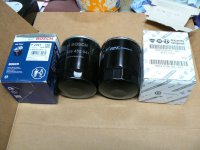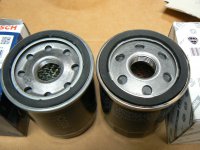I was just re-watching the Continental video clip I posted the link to above and it occurs to me that less experienced people will be thinking "Well, without that electronic sonic tension checking tool I won't be able to do this". Nothing could be further from the truth!
Tensioning the belt correctly on these older designs is just a little more demanding than on later designs because the later designs incorporate a spring tensioner within the setup. The tensioner applies pressure to the belt because it's mounting bolt is excentric to the axis of the bearing so rotating it about it's mounting bolt alters the tension on the belt. On later setups the correct tension is usually applied when the tensioner is rotated until two pointers are in line and the locking nut tightened up. The integral spring arrangement allows the tension to be uniform as it allows small movements of the tensioner under the influence of the spring when the engine is running and requires very little judgement to be exercised by the installer, just line up the pointers.
On the earlier setup there is no automatic spring tensioner so the tensioning roller, once it's locking nut is tightened, will be applying whatever tension has been achieved by the installer during instalation.
I got very obsessed with belt tensioning when I first got involved with doing timing belts back in the '70's - cars like the Fiat 128, Ford Cortina (Pinto engine) Leyland Princess & Marina with the "O" series engine etc, etc. My recollection is that most of these engines had "fixed" tensioners (I seem to remember the Pinto had an interesting spring which applied pressure to the tensioner before you tightened it's locking nut to try to eliminate the "rogue" element of inexperienced fitters, but once tightened it was fixed.
My old '92 Panda Parade had a fixed tensioner. Our newer 2010 Panda Dynamic eco has the more modern "automatic" spring type tensioner and I think the spring type "automatic" tensioner is a very big improvement because, as long as you line up the marks/pointers you will achieve correct tension. Fixed tensioners pose a bit more of a problem for the inexperienced.
There are numerous videos showing you how to adjust the tension until you can twist the longest run of the belt through a quarter of a turn by applying "reasonable" force to it by hand. This video shows the test at about 20 seconds in:
https://www.youtube.com/watch?v=9RAUtE2aztk and it's quite a good way to check a belt for tightness.
However, always a "however" isn't there? it occurred to me that engines get very hot when they are working and hot things, in general, expand don't they? So I started wondering if the centre distance between the crankshaft sprocket, camshaft sprocket, water pump sprocket (if it's the type of engine that incorporates the water pump in the cam drive) and the tensioner changes noticeably when the engine is hot compared to when it's cold. So I observed several engines fitted with automatic spring tensioners and guess what? Yes it does! Most tensioners are set up with the engine cold where the pointers on the tensioner are set to line up/overlap or whatever. When the engine is fully up to temp - so after a good drive when the block etc will be fully heat soaked, the pointers are substantially offset. Of course the automatic tensioner compensates for this with it's spring but I started thinking then "what about the older "fixed" type which lacks this feature. So i started experimenting with Felicity - our '92 Panda which has the "fixed type" tensioner. If you set the belt to the 90 degree twist when cold then it's really "bow string" tight when full up to temp. This worried me so I evolved this way of doing them.
1. Fit the belt, tensioner etc and adjust until the belt is not actually loose but not "tight" either. The engine can now be run up to full temperature with no fear of the belt getting too tight. Needs to be run for maybe 15 minutes after achieving normal temp on the gauge or better still, taken for a wee drive but that might be inconvenient if a lot of guards and mounts etc need to be replaced and then stripped off again.
2. Stop the engine and let it sit for maybe 5 minutes for the heat to generally equalize throughout.
3. With a spanner/socket on the crank bolt slightly turn the engine DOR to make sure the "driving side" of the belt is fully tensioned with no slack and slacken the tensioner locking nut about half a turn or so - just enough so the tensioner can be easily moved.
4. Select the longest run of the belt on the "slack" side - on our Pandas etc this would be on the left looking at the "front" of the engine between the crank sprocket and tensioner - and place your forefinger on one side of the belt and thumb on the other. Now SLIGHTLY slacken the tensioner and "waggle" the belt between your finger and thumb. You'll feel a small amount of "slack".
5. Slowly and gently rotate the tensioner until the slack you are feeling is completely eliminated but you are not attempting to "stretch" the belt either. As a matter of interest if you try the quarter turn test now you'll find it works perfectly. However what you will find when the engine is completely cold is that there is a just perceptible, infinitesimally small, amount of "slack" in the belt if you try waggling it because, of course, there is no spring loading to take it up.
Note. Describing the cold belt as having "slack" is not really right, a slight lack of tension might describe it best? I've adjusted belts on a wide variety of older engine using this method and never known of a problem being caused. My "worry" with fixed (non automatic) tensioners is that if you adjust the belt tightly with the engine cold it will then be very much too tight when the engine is hot and I think this worry is well founded as you used to hear tight belts "singing" at traffic lights and when in slow moving traffic quite often, but these days, with most tensioners being of the automatic type, I can't really remember when I last heard a singing/whining belt?



